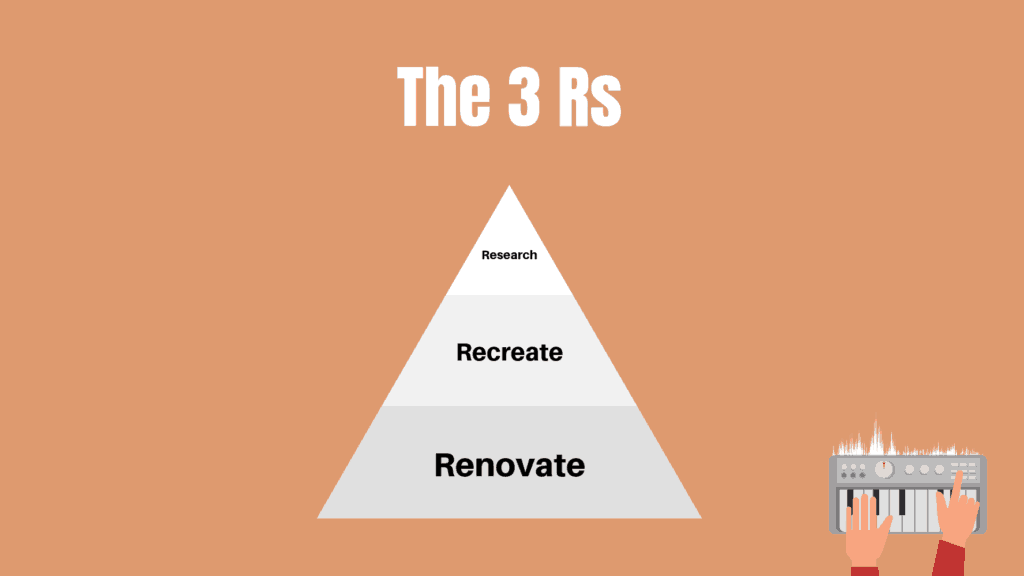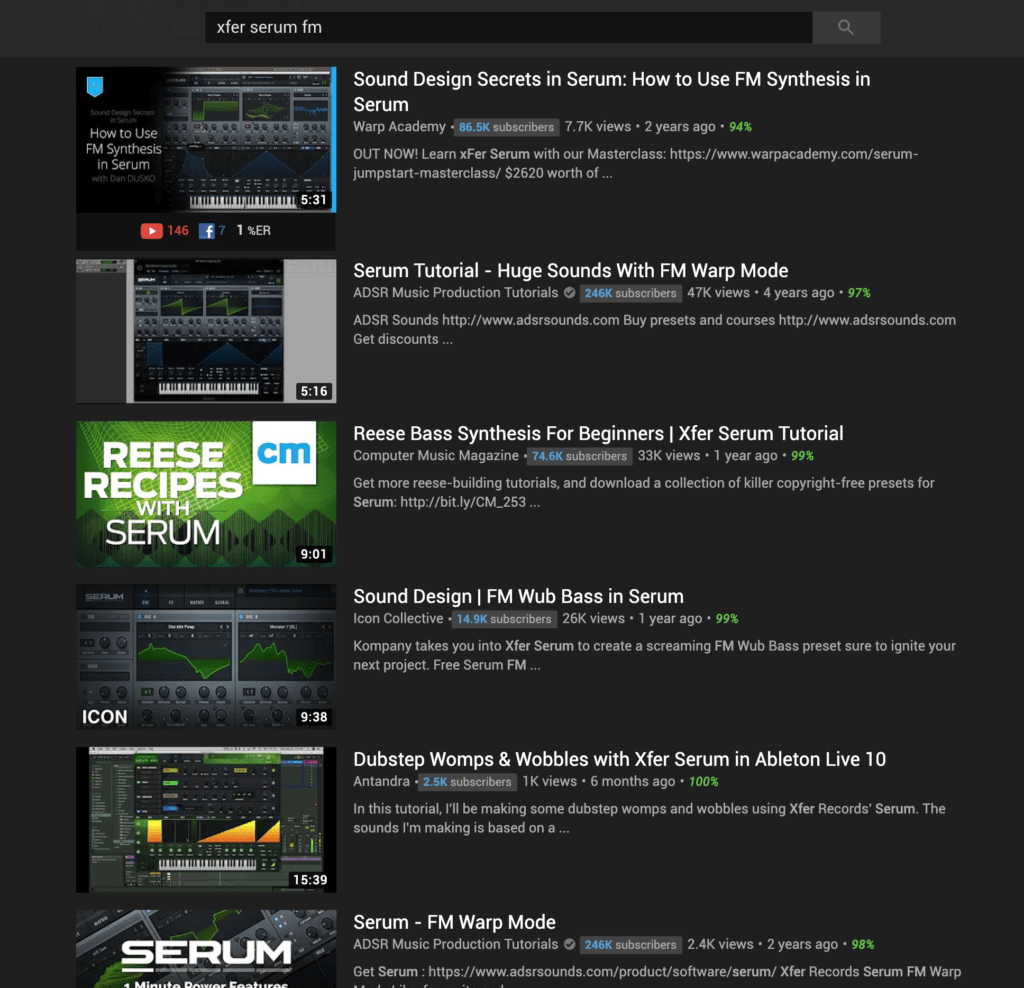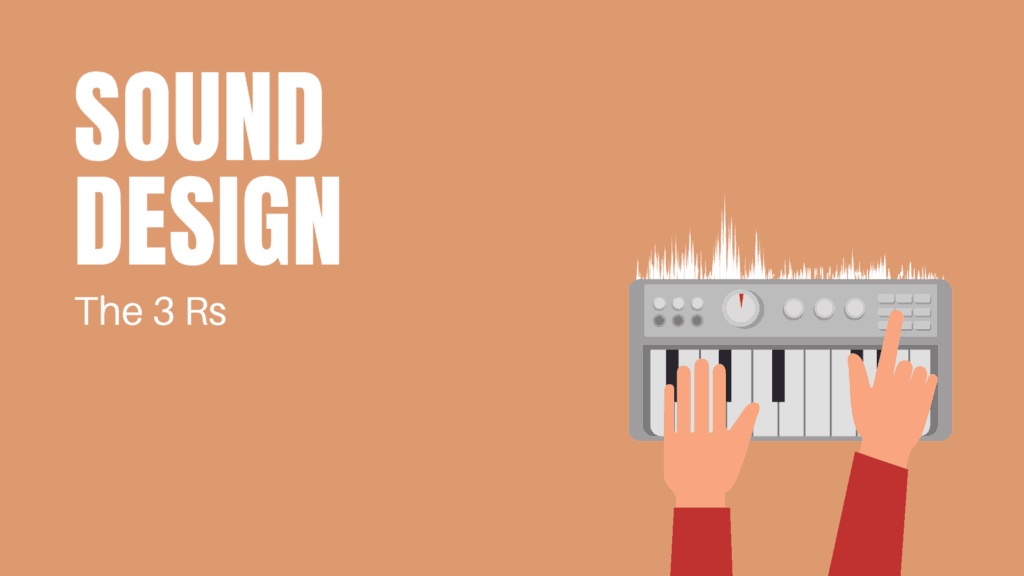Sound Design is what makes music production fun.
It might be why you chose to pursue production rather than a traditional instrument.
But when you start, it’s overwhelming and frustrating to learn. Sound design tutorials aren’t enough.
In fact, when I started out, I literally spent hours aimlessly staring at my synth (Massive), trying to see how it worked.
I had no process of learning it, and it took me way longer than it should have to become any good.
And most of the resources out there were all about theatre, film and video games. They were helpful, but not always specific to electronic music.
Looking back, if I had a framework for learning it, I would have skyrocketed my knowledge and skills.
That’s why I’ve created The 3 Rs framework for Sound Design – so you won’t make the same mistakes I did.
Note: want some free presets to dissect? Download our free EDM Essentials for Serum pack below.
Want Serum presets that work out of the box?
Download our FREE EDM Essentials for Serum preset pack with 60+ high-quality sounds – from soaring leads to smooth pads. Suitable for any genre, style, or sound.
What is Sound Design?
Before we get into The 3 R’s, we have to first articulate what sound design actually is. Here’s how Wikipedia defines it:
“Sound design is the art and practice of creating
But this is pretty general and doesn’t specifically relate to electronic music production. Below is how we define it:
Sound Design is the technical and creative process of creating sounds through synthesis, recording, sampling and/or manipulating.
It’s a very broad process with many different elements, but those are the main four. Here is what each of them means:
Synthesis – The process of creating sound from oscillators and waveforms. Synthesis is usually what most people think of when they think ‘sound design’, but in reality, it is much broader than that. This includes both digital and analogue synthesis.
Recording – The process of capturing acoustic sounds. These sounds are usually for a specific effect, like foley or texture, and are usually processed after recording.
Sampling – The process of using existing audio to create new sounds. You might have a library of samples to use as raw material for your own sounds.
Manipulating – The process of taking any sound from a source and processing it with FX and other devices to alter it. Manipulating can occur on synthesised, recorded or sampled sounds.
Sound Design is just one part of electronic music production, but it is a very broad and multifaceted art form.
Recommended: 100 Sound Design Tips
A Better Way to Learn
So we know what sound design is, but how do we learn it? This is where most producers get lost.
Most people get by on watching a few tutorials and playing around.
You can learn this way, but if you want to become good at a rapid pace, you need a plan to follow.
A plan based on action and deliberate practice, not just head knowledge.
So after many years of playing around with
It’s simple and it’s something you can start using right now in your own music.
Let’s get into The 3 R’s.

Renovate
The first of the three ‘R’s is ‘Renovate’.
This stage should come first and aims to help you dip your feet in sound design without overwhelming yourself.
You don’t have to make anything from scratch, but it’s the best way to learn, fast, because you’re observing how other experienced sound designers and producers have created their sounds, and then building on top of that.
This means to observe and tweak the presets and/or sounds that come with the synth or DAW (or download presets/sounds and tweak them.)
Most people try and read the manual first, which is not necessarily a bad idea.
But let’s be honest, to read the whole manual is a chore and isn’t conducive of remembering the different aspects of sound design. It still can be beneficial though, and we’ll delve into this a bit later.
For now, let’s say you’ve just bought Xfer Serum. You’ve seen a few reviews and can’t wait to delve in. But you don’t know where to start. Here’s what you should do:
- Go through the library and find a few presets/sounds that catch your ear
- Download some extra preset packs in a style you want to make
- Save them or remember which ones they are
- Play some notes and navigate your way around the preset/sound
- Take note of what is happening in the sound
- Tweak random knobs and see how it affects the sound
- Save your own versions
- Move onto the next preset and apply what you learned
Repeating this process will help you learn sound design the fastest way possible. It requires minimum knowledge but requires active engagement in using the synth, while learning the workflow behind some of your favourite sounds.
Once you’ve spent a few weeks doing this, you can move onto the second ‘R’.
Recreate
‘R’ number two is ‘Recreate’.
Once you’ve started seeing how other sounds are made in your software, try recreating it knowing the techniques you’ve learned by watching how others have made their sounds.
What’s important about this is that you are still staying in your plugin/DAW and not venturing onto YouTube and just watch tutorials (yet). To learn sound design properly, actively using the software is the best way to learn.
This is the ‘Recreate’ process:
- Start with an init preset/sound along with a second instance of a preset sound
- Use the techniques you’ve learned previously to create the same sounds
- Repeat while slowly removing the second instance as a reference, until you are making sound without looking
By the end of this stage, essentially you can recreate sounds from scratch without looking. By now, you are probably wanting to branch out and get your own touch on sounds.
Research
The last of the ‘R’s is research.
You might be thinking, “Aden, I get that it helps to have a framework, but research? C’mon, this isn’t school!”
Well,
Research has two parts to it, that you must keep in balance to accelerate your sound design learning: knowledge and experimentation.
Knowledge
In this section, you can finally watch some YouTube tutorials.
Knowledge is the less important of the two, but gaining knowledge does help speed up the process if you do it right.
The problem is, a lot of people do this before the ‘Renovate’ and ‘Recreate’ stages, and never actually get any sound design done. They just get head knowledge.
You can learn this way, but it’s slower and less effective.
That being said, once you’ve learned a bunch from the first two stages, gaining knowledge can help fill any gaps that you haven’t learned from the first two ‘R’s.
Tutorials and resources these days are also in such high supply. Look at all the results that come up on YouTube when I search for ‘xfer serum fm’:

This wouldn’t have happened in 2009 when I first started producing.
It’s also super helpful for finding new ideas for sounds and it also shows the whole process from start to finish.
This knowledge can come from:
- RTFM (the manual)
- tutorials that show you how to make a certain sound
- tutorials that show you how to do a particular type of synthesis
- walkthrough articles
- reading books on sound design (The Sound Effects Bible is an interesting read
It shows you a way to learn something, but you need to make sure you put the knowledge into practice.
Don’t fall into the trap of watching heaps of tutorials and never doing anything on your own.
Yet, a good scientist knows to use both secondary data (information from another source) and primary data (self-created knowledge).
This is where part two of ‘Research’ comes in – experimentation.
Experimentation
This is the stage where you take everything you’ve learned and start to make your own sounds from scratch, while deliberately trying new things to build up your skills.
Create new sounds that you haven’t heard before.
Use your knowledge but also do things out of the ordinary.
Tweak a knob you’ve never touched before and then see what happens.
Learning by doing is probably the most powerful way to learn absolutely anything.
Experimentation is the last phase of this process because it helps to define your sound as a producer. The sounds you curate and create are important and can help you to stand out from the crowd.
What are you waiting for? Go open your DAW and start tweaking.
A Few Notes
Now it’s recommended you follow The 3 Rs in order, but sometimes you might find you need to swap between methods to achieve what you want.
Maybe you just don’t understand what a certain effect does, so you need to check the manual. That’s fine!
This framework is designed to guide you through your sound design journey, not hinder it. So make sure to adapt this to your own learning style and situation.
Also, remember that sound design is for more people than those who just want to make bass growls. Sound design is all-encompassing – it’s the creation of all sounds.
This guide can be used anyone – from those who want to make chill pads, to those who want to make banging trap leads.
If you want some presets to start renovating, grab our free EDM Essentials for Serum pack below!
Want Serum presets that work out of the box?
Download our FREE EDM Essentials for Serum preset pack with 60+ high-quality sounds – from soaring leads to smooth pads. Suitable for any genre, style, or sound.
Lastly, if you have any questions about sound design or The 3 Rs, let me know by hitting me up at [email protected].

